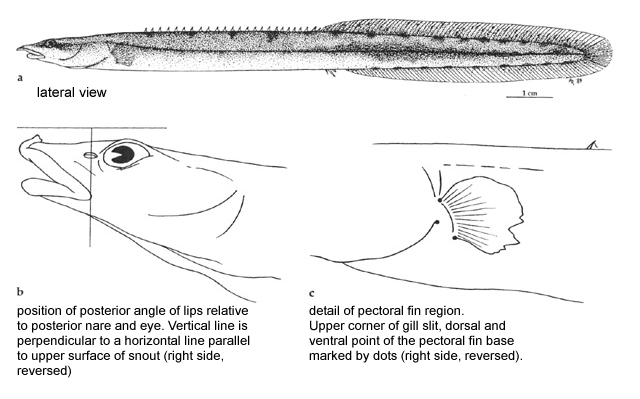|
Dorsal spines (total): 25-27; Dorsal soft rays (total): 72-85; Anal spines: 3-3; Anal soft rays: 66-79; Vertebrae: 86-88. Diagnosis: head length 14.2-14.9% SL (mean 14.6%), decreasing with size (Ref. 81678). Origin of first dorsal spine situated behind posterior edge of pectoral fin, 2.5-9.9% SL (mean 5.3%)(Ref. 52436, 81678). Body depth 6.7% SL; distance from tip of snout to last externally visible dorsal spine 50.5-51.6% SL (mean 51.2%), decreasing with size (Ref. 81678). Origin of soft dorsal fin clearly anterior to origin of soft anal fin (Ref. 52436, 81678). Lower jaw length 21.3-26.9% HL (mean 23.9%), increasing with size; distance from gill opening to dorsal pectoral fin base 4.3-9.6% HL (Ref. 81678). 24+1 to 26+1 (median 25+1) dorsal spines; no preorbital spines; no preopercular spines (Ref. 52436, 81678). Color pattern characterized by a series of mediodorsally situated dark brown to black spots on body, tail and proximal parts of dorsal and anal fins (Ref. 52436).
Description: snout blunt; posterior angle of lips below posterior nare; upper corner of gill opening slightly anterior to dorsal point of pectoral fin base, both points clearly anterior to ventral point of pectoral fin base; gill slit open; upper corner of gill opening situated about opposite or halfway above mid-base of pectoral fin; lateral line continuous from head up to about 1/3 of distance between head and anus, discontinuous further posteriorly; rostral appendage short (Ref. 52436). Preanal length negatively allometric, postanal length positively allometric, about equal in small specimens (<130mm) (Ref. 52436, 81678). Preanal length clearly shorter in larger specimens (Ref. 52436). Preanal length 48.6-49.7% SL (mean 49.1%), postanal length 48.8-50.6% SL (mean 49.5%) (Ref. 81678). Distance from tip of snout to last externally visible dorsal spine negatively allometric, shorter than distance from tip of snout to last externally visible anal spine, negatively allometric (Ref. 52436, 81678). Distance from anterior border of snout to last externally visible anal spine 53.5-56.1% SL (mean 54.7%)(Ref. 81678). Dorsal spines, with spines increasing in size from first to last; 1 additional very short spine hidden under skin, anterior to base of first dorsal fin ray; 2 externally visible anal spines, first one smaller than second; 1 additional very short spine, hidden under skin, situated anterior to base of first anal fin ray; 1st anal pterygiophore well developed, supporting first and second anal spine, and only pterygiophore supporting 2 spines: neural spine supporting pterygiophore of last externally visible dorsal spine and haemal spine supporting pterygiophore of first anal spine situated on 2 different vertebrae, separated by 1-2 vertebrae; vertebra with neural spine supporting pterygiophore of last externally visible dorsal spine always in front of vertebra with haemal spine supporting first anal spine (Ref. 52436). 75 mean soft rays in dorsal fin, 75/76 in anal fin; difference between number of soft dorsal fin rays and number of soft anal fin rays (-3)-(+7) (mean +4); 9-12 caudal fin rays (mean 11); 6 predorsal vertebrae (mean 6); 31-32 abdominal vertebrae (mean 32); (0)-(+2) in-between vertebrae (mean +1); 54-57 caudal vertebrae (mean 54/55), 86-88 mean total vertebrae (Ref. 81678).
Coloration: In preservation: overall colour uniformly light brown; dorsal mid-line with a series of dark brown, black spots extending along dorsal, caudal and anal fin bases; ventral surface of head, belly and abdomen yellowish white with no spots or markings; distal portions of dorsal, caudal and anal fins whitish to transparent; basal part of dorsal, caudal and anal fins brownish; head, sides and tail uniformly brown; pectoral fins whitish with no spots or markings (Ref. 52436, 81678). Dark brown band originating at base of rostral appendage, passing through eye, fading further posteriorly; proximal part of dorsal and anal fin with a series of large, dark brown spots, partially also situated on tail (Ref. 52436). |

